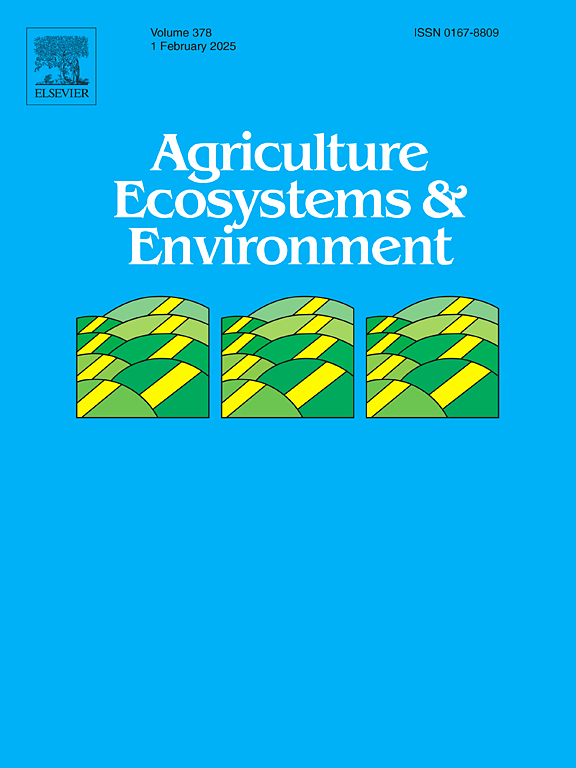Simulating and mapping the risks and impact of fall army worm (Spodoptera frugiperda) and white grub (Holotrichia serrata) in maize production outlooks for Nigeria under climate change
IF 6.4
1区 农林科学
Q1 AGRICULTURE, MULTIDISCIPLINARY
引用次数: 0
Abstract
Agriculture in many developing countries is expected to be severely affected by climate change. The majority of Africa’s population traditionally depends on maize for their livelihoods. The recent invasion and spread of the fall armyworm (FAW), white grubs and other maize pests in Africa is therefore one of the major factors hindering sustainable food security on the continent. Estimating the simultaneous impact of climate change and major pests on maize yields, its spatio-temporal pattern and narrow time windows is most useful for early warning, but is not addressed in the current literature. We present an approach based on remotely sensed climate and biophysical data and agro-system modelling to fill this gap, using Nigeria as an example. We start from a baseline maize yield simulation that produces mean yields of 800–1200 kg ha–1, 1000–1700 kg ha–1 and 1200–2300 kg ha–1 under low, medium and high nitrogen supply, respectively. Potential pest impacts can be responsible for mean yield losses of up to 18–75 % and 8–73 % (USD 72.4 – 675.3 ha–1) for white grub and FAW, respectively, under different severity thresholds, depending on locations and when maize was sown. Our findings further collaborates that yield losses due to pests outweigh the direct effects of climate change. Importantly, our findings reveal the influence of changing sowing windows on the magnitude of yield losses. Early sowing resulted in higher yield losses, while medium and late sowing generated lower yield losses for all simulated years. Our pest risk predictions show moderate to high growth index numbers for FAW to occur in Nigeria, especially in the 2021–2060 windows, and most favourable in the cropping seasons in all agro-ecological zones (AEZs). Favourable breeding conditions for FAW decreased over time and were almost absent in the savannahs by 2100. However, the risk projections show higher stress indices occurring from 2081 to 2100 and a decline in growth index counts. This information is key to understanding pest adaptation in Nigeria, and how crop management can support sustainable yield improvements. The findings can be used to improve organic crop management and facilitate policy formulation for future climate change adaptation and mitigation for optimised agricultural production, innovative chemical control, sustainable environmental management, progressive agribusiness and secure access to food in Nigeria.
模拟和绘制气候变化下尼日利亚玉米生产前景中秋军虫(Spodoptera frugiperda)和白蛴螬(Holotrichia serrata)的风险和影响
许多发展中国家的农业预计将受到气候变化的严重影响。非洲大多数人口传统上以玉米为生。因此,最近秋粘虫(FAW)、白蛴螬和其他玉米害虫在非洲的入侵和蔓延是阻碍非洲大陆可持续粮食安全的主要因素之一。估计气候变化和主要害虫对玉米产量的同时影响,其时空格局和窄时间窗对早期预警最有用,但目前的文献尚未解决。我们以尼日利亚为例,提出了一种基于遥感气候和生物物理数据以及农业系统建模的方法来填补这一空白。我们从基线玉米产量模拟开始,在低、中、高供氮条件下,平均产量分别为800-1200 kg ha-1、1000-1700 kg ha-1和1200-2300 kg ha-1。根据不同的播种地点和时间,在不同的严重程度阈值下,潜在虫害影响可导致白蛴螬和FAW的平均产量损失分别高达18 - 75% %和8 - 73% %(72.4 - 675.3 ha-1美元)。我们的研究结果进一步表明,害虫造成的产量损失超过了气候变化的直接影响。重要的是,我们的研究结果揭示了改变播种窗口对产量损失程度的影响。在所有模拟年份中,早播造成的产量损失较大,而中播和晚播造成的产量损失较小。我们的有害生物风险预测显示,尼日利亚的FAW将出现中高增长指数,特别是在2021-2060年窗口期,并且在所有农业生态区(aez)的种植季节最有利。随着时间的推移,FAW的有利繁殖条件逐渐减少,到2100年在大草原上几乎没有。然而,风险预测显示,从2081年到2100年,压力指数较高,增长指数计数下降。这些信息是了解尼日利亚病虫害适应情况以及作物管理如何支持可持续提高产量的关键。这些发现可用于改善有机作物管理,促进制定政策,以促进未来气候变化的适应和缓解,从而在尼日利亚优化农业生产、创新的化学控制、可持续的环境管理、渐进的农业综合企业和安全的粮食获取。
本文章由计算机程序翻译,如有差异,请以英文原文为准。
求助全文
约1分钟内获得全文
求助全文
来源期刊

Agriculture, Ecosystems & Environment
环境科学-环境科学
CiteScore
11.70
自引率
9.10%
发文量
392
审稿时长
26 days
期刊介绍:
Agriculture, Ecosystems and Environment publishes scientific articles dealing with the interface between agroecosystems and the natural environment, specifically how agriculture influences the environment and how changes in that environment impact agroecosystems. Preference is given to papers from experimental and observational research at the field, system or landscape level, from studies that enhance our understanding of processes using data-based biophysical modelling, and papers that bridge scientific disciplines and integrate knowledge. All papers should be placed in an international or wide comparative context.
 求助内容:
求助内容: 应助结果提醒方式:
应助结果提醒方式:


